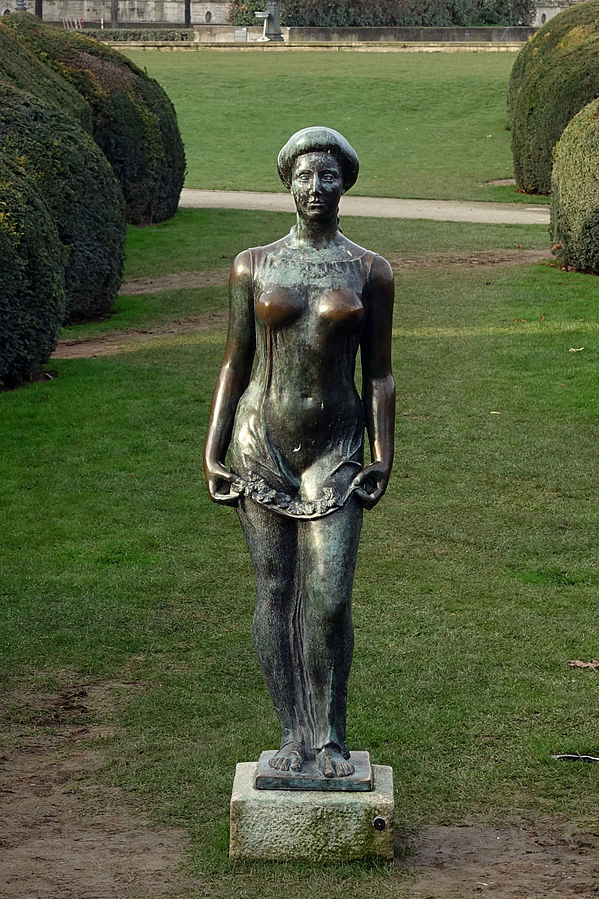
Façade of the Maillol Museum, 1739-45, by Edmé Bouchardon
© Sophie Llyod


In 1739, the nuns of the Récollettes convent donated a site to the city for the construction of a monumental fountain in the heart of the neighbourhood. Edme Bouchardon, official sculptor to the King, created the majestic Quatre-Saisons Fountain, built from 1739 to 1745 in honour of the City of Paris. Today, it forms a majestic foreground to the façade of the museum. The structure was classified as a historical monument in 1862.

View of the former spaces of the permanent collection at the Musée Maillo l© Sophie Llyod


In the decades following the construction of the fountain, the nuns began to erect some of the buildings in which the museum's rooms are located today.

Anonymous photographer, "Cour du 59 rue de Grenelle", 1950's. © Paris, Archives Fondation Dina Vierny - Musée Maillol


During the Revolution, the convent was closed and sold at auction. The various buildings were sold to private individuals and underwent major alterations and reconstruction, giving the courtyard its current appearance in the early years of the 19th century.

Charles Landelle, "Portrait de Musset", 1878, oil on canvas, Versailles, Musée National du Château de Versailles


In the 19th century, the building housed famous names, such as the poet Alfred de Musset, who lived there with his mother for a considerable period. The painter Paul Jacques Aimé Baudry also lived in a large studio, the layout of which was faithfully preserved during the renovation of the museum, and which now houses life-size sculptures by Maillol on the second floor.

Légende à entrer


In 1951, the Prévert brothers opened a cabaret, La Fontaine des Quatre-Saisons, in the large exhibition hall with columns on the ground floor. Boris Vian, a regular at the venue, created Le Déserteur; Francis Blanche presented his sketches; the Frères Jacques and Yves Montand sang Prévert's poems set to music by Kosma. A plethora of young artists made their debut there: Maurice Béjart, Guy Bedos, Pierre Perret, Jean Yanne, Philippe Clay, Jacques Dufilho…

Photographer: Louis Carré, Dina Vierny and Aristide Maillol in Banyuls-sur-Mer, January 1944. Archives Dina Vierny-Musée Maillol Foundation, Paris


In 1955, Dina Vierny, model and collaborator of Aristide Maillol, bought and lived in a flat in this building. Little by little, over a period of thirty years, she managed to buy the entire building.

Aristide Maillol, "Flore", 1910, bronze, 164x52x36 cm, Paris, Jardin du Carrousel


Dina Vierny and Lucien Maillol donated sculptures by Maillol to the State. André Malraux, Minister of Cultural Affairs, decided to install 20 of them in the Tuileries gardens (17 installed in 1964-1965; 1 in 1972 and 2 in 1995). It is a true "open air Musée Maillol".

Jean-Alex Brunelle, "François Mitterand and Dina Vierny inaugurate the Maillol Museum", 20 January 1995 © Paris, Archives Fondation Dina Vierny - Musée Maillol


After 15 years of renovation work the museum dedicated to Maillol, created by Dina Vierny, finally opened its doors on 20 January 1995. Inaugurated by the President of the Republic François Mitterrand, it presented to the public the most important collection of works by the artist and gave a complete overview of his creation in sculpture, painting, drawing, ceramics and tapestry. Dina entrusted the management of the museum to her sons Olivier and Bertrand Lorquin until 2009. Between 1995 and 2015, exhibitions honouring great names in the history of art were organised: Francis Bacon, Klimt, Diego Rivera and Frida Kahlo, Morandi, Basquiat, Keith Haring, Poliakoff, Botero, Rauschenberg, Bonnard, etc.
Mentions légales | CGU | Données personnelles | Gestion des cookies
Musée Maillol, 2021
Mentions légales | CGU | Données personnelles | Gestion des cookies
Musée Maillol, 2021